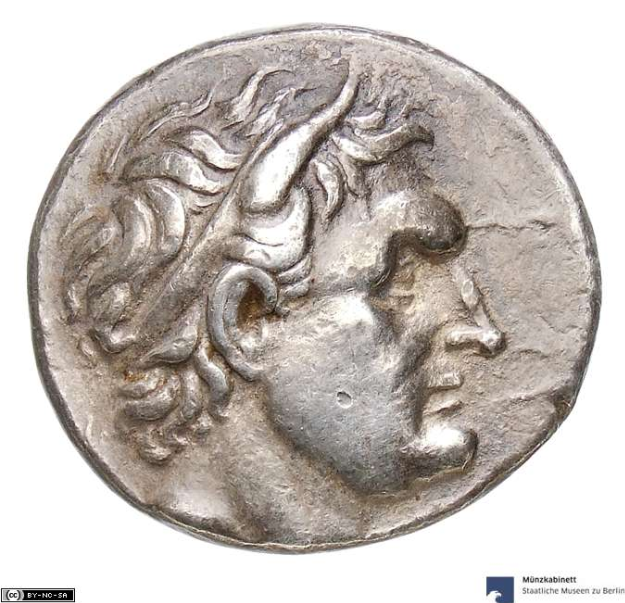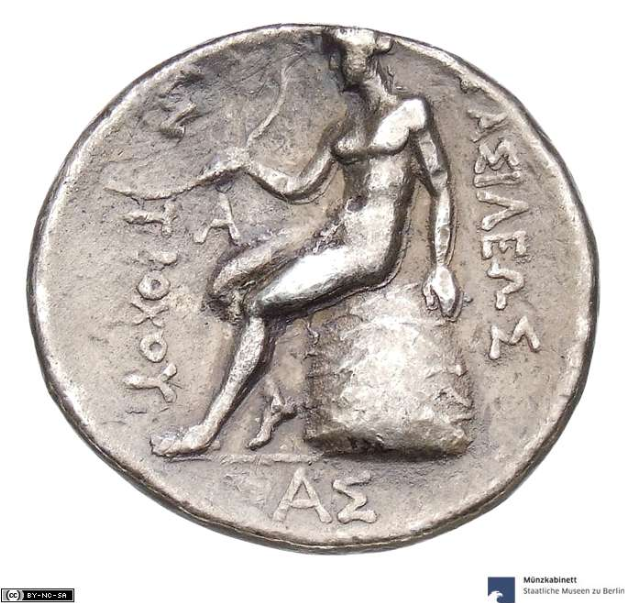Beyond Mainland Greece: Seleucid Coinage – by Ellis Jones.
Our final post in the Beyond Mainland Greece series for 2019-2020 is by Ellis Jones. Dr Stephen Harrison, module convenor, writes: One of the major differences between the Achaemenid and Seleucid periods was the spread of coinage across Asia during the Seleucid era. Coins were important for lots of reasons – and not just as a form of payment (indeed, there were lots of ways other than money to pay for things in the ancient world). One other reason for their production was to communicate key aspects of royal ideology to a reasonably wide audience – while not everybody would handle these coins, they were likely to be seen by more people than those who saw (and could read) royal inscriptions.


Images sourced from: https://ikmk.smb.museum/object?lang=en&id=18228232&view=vs
Ellis Jones:
While serving a monetary purpose, numismatics also serve to circulate propagandistic portraits with the ultimate aim of legitimising monarchical rule. This coin, issued by Antiochus I and minted in Sardis, depicts an idealised image of Seleucus I with an anastole hairstyle, that become synonymous with the previous ruler, Alexander the Great’s, power. [1]
Although the coin was not minted by Seleucus himself, the iconography implemented by his son must have originated from Seleucus’ own desired self-portrait especially when compared with his rival successors identical imagery. Ptolemy, [2] Lysimachus, [3] Cassander [4] and Philip Arrhidaeus, [5] share the same anastole hair as Alexander in their numismatic portraits. This geographically widespread use of the exact same emblem amongst Alexander’s contemporaries confirms its status as a deliberate notification of legitimate power. This is especially true when paired with the understanding of coin distribution to the Macedonian Army; the support of the army was integral to the success of any individual hoping to continue Alexander’s leadership, therefore the use of familiar imagery associated with their fallen general would have served as an incentive for the army to support the individual who most closely resembled Alexander. This adoption of hair as a power symbol is not restricted to Seleucid coinage but can be seen in the same region in the Achaemenid emulation of Assyrian beards, with the same purpose to align their rule with that of a past successful empire. [6] Antiochus’ depiction of his father further resembles Alexander in the fact that, with the hair paired with the clean-shaven face, Seleucus appears youthful, resonant not only of Alexander’s untimely death but also an ideal, invulnerable king who has the ability to continue his reign. This is perhaps reflective of Antiochus’ desire to remind his audience of the continuation of the Seleucid empire through his own reign and those who will follow.
The conscious decision to depict Seleucus with Alexander’s iconic hair does not however simply serve to rival his contemporaries during a succession crisis, but also as a means to legitimise Seleucid rule to its subjects. The development of the anastole hairstyle as an identifiable symbol of kingship is evident through the continued use of such iconography in Seleucid coinage, all the way down to the short reign of Diodotus Tryphon c.140BC. [7] This continued use of the same iconography results in the continuing debate in identifying individuals on coins. Despite the ambiguous depiction, there is an agreement that the depicted individual is powerful, based on the illustrated hair. Although the iconography of Antiochus III poses an anomaly in its lack of anastole, his adoption of the epithet “the Great” suggests an alternative legitimising tactic; putting himself on par with Alexander in name over image. [8] The anastole as a power symbol continues to the Roman Republic in Pompey’s portraiture.
It is therefore clear that the iconography chosen to depict Seleucus I was a conscious decision to communicate the power of the new Seleucid empire. The adoption of the anastole on this coin is deliberate imperial propaganda.
Footnotes
[1] Bieber. 1949. 374.
[2] BM0101.1
[3] BM0120.60
[4] BM0409.243
[5] BM0411.287
[6] DB, BM124911
[7] BM0710.22
[8] Seleucid Coins no. 1133, no. 1068
Bibliography
Ancient Sources
Architectural Sculpture
Lendering, J. (2004). https://www.livius.org/sources/content/achaemenid-royal-inscriptions/. 25/02/19.
British Museum. (2019, April 01) British Museum collection database. Retrieved from http://www.britishmuseum.org/research/collection_online/search.aspx.
Coinage
British Museum. (2019, April 01) British Museum collection database. Retrieved from http://www.britishmuseum.org/research/collection_online/search.aspx.
Seleucid Coinage
Seleucid Coins Online. URL: http://numismatics.org/sco/. Accessed on: 2nd April 2019.
British Museum. (2019, April 01) British Museum collection database. Retrieved from http://www.britishmuseum.org/research/collection_online/search.aspx.
Modern Scholarship
Bieber, M. (1949). The Portraits of Alexander the Great. Proceedings of the American Philosophical Society, 93, 373 – 421.
Dahmen, K. (2007). The Legend of Alexander the Great on Greek and Roman Coins. London: Routledge Taylor and Francis Group.
Fulińska, A. (2011). The god Alexander and his emulators. Alexander the Great’s “afterlife” in art and propaganda. In J, Styka & S, Śnieżewski (Eds), Studies of Greek and Roman Literature and Culture (125 – 136). Kraków: Księgarnia Akademicka.
Haas, N. (2005). Hairstyles in the Arts of Greek and Roman Antiquity. Journal of Investigative Dermatology Symposium Proceedings, 10, 298 – 300.
Hadley, R. (1974). Seleucus, Dionysus, or Alexander? The Numismatic Chronicle, 7, 10, 9 – 13.
